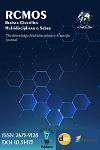Scenario Planning for the Resilience of U.S. Supply Chains: Modeling the Impacts of Geopolitical Disruptions and Freight Cost Volatility
Scenario Planning for the Resilience of U.S. Supply Chains: Modeling the Impacts of Geopolitical Disruptions and Freight Cost Volatility
DOI:
https://doi.org/10.51473/rcmos.v1i1.2025.1420Keywords:
scenario planning; resilience; freight costs; geopolitics; TTS/TTR; United States.Abstract
This article examines the use of scenario planning as a decision-making tool to strengthen the resilience of U.S. supply chains in the face of geopolitical disruptions such as sanctions, conflicts, embargoes, and regulatory shocks, as well as the volatility of freight costs across ocean, rail, road, and air transport. The research integrates the operations and risk literature with strategic intelligence practices, proposing a method that connects plausible narratives to quantitative models—discrete event simulation, system dynamics, and Monte Carlo—generating metrics for TTS/TTR, OTIF, Operational VaR, and avoided loss under different trajectories. It argues that the usefulness of scenarios is enhanced when linked to signposts and decision triggers, which activate contractual optionalities, structural buffers, and multi-gateway rerouting. Evidence from sector reports and public policies, such as the National Freight Strategic Plan (USDOT), indicates that the combination of modular architecture, inter-organizational data, and contracts with options contributes to reducing the area of the “resilience triangle” and protecting margins in shock contexts (SHEFFI, 2015; CHOPRA; MEINDL, 2016; USDOT, 2020; UNCTAD, 2020; SEA-INTELLIGENCE, 2021).
Downloads
References
CHOPRA, S.; MEINDL, P. Supply Chain Management: Strategy, Planning, and Operation. 6. ed. Boston: Pearson, 2016.
CHRISTOPHER, M. Logistics & Supply Chain Management. 5. ed. Harlow: Pearson, 2016.
CLARKSONS RESEARCH. Container Intelligence Quarterly. London: Clarksons Research, 2021.
DREWRY. Container Forecaster. London: Drewry Maritime Research, 2021.
EIA – U.S. ENERGY INFORMATION ADMINISTRATION. Short-Term Energy Outlook. Washington, DC: EIA, 2021.
HARALAMBIDES, H. E. Gigantism in container shipping, ports and global logistics: a time-lapse into the future. Maritime Economics & Logistics, v. 21, p. 1–60, 2019. DOI: https://doi.org/10.1057/s41278-018-00116-0
IAPH – INTERNATIONAL ASSOCIATION OF PORTS AND HARBORS. COVID-19 Port Economic Impact Barometer. Antwerp: IAPH, 2020.
ISO. ISO 22301:2019 — Security and Resilience — Business Continuity Management Systems — Requirements. Genebra: ISO, 2019.
IVANOV, D.; DOLGUI, A. Viability of intertwined supply networks: extending the supply chain resilience angles. International Journal of Production Research, v. 58, n. 10, p. 2904–2915, 2020. DOI: https://doi.org/10.1080/00207543.2020.1750727
NOTTEBOOM, T.; PALLIS, A. Port Economics, Management and Policy: COVID-19 and the Impact on Ports. Relatórios/briefs, 2020. DOI: https://doi.org/10.4324/9780429318184
NOTTEBOOM, T.; RODRIGUE, J.-P. Port congestion and the destabilization of supply chains in 2020/2021. Maritime Economics & Logistics, 2021.
OECD/ITF – INTERNATIONAL TRANSPORT FORUM. Policies to Enhance Intermodal Connectivity and Performance. Paris: OECD Publishing, 2016.
PONOMAROV, S. Y.; HOLCOMB, M. C. Understanding the concept of supply chain resilience. The International Journal of Logistics Management, v. 20, n. 1, p. 124–143, 2009. DOI: https://doi.org/10.1108/09574090910954873
RODRIGUE, J.-P. The Geography of Transport Systems. 4. ed. New York: Routledge, 2020. DOI: https://doi.org/10.4324/9780429346323
SCHOEMAKER, P. J. H. Scenario planning: a tool for strategic thinking. Sloan Management Review, v. 36, n. 2, p. 25–40, 1995.
SEA-INTELLIGENCE MARITIME ANALYSIS. Global Liner Performance (GLP) Report. Copenhagen: Sea-Intelligence, 2021.
SHEFFI, Y. The Power of Resilience: How the Best Companies Manage the Unexpected. Cambridge, MA: MIT Press, 2015. DOI: https://doi.org/10.7551/mitpress/9780262029797.001.0001
SIMCHI-LEVI, D.; KAMINSKY, P.; SIMCHI-LEVI, E. Designing and Managing the Supply Chain: Concepts, Strategies and Case Studies. 3. ed. Boston: McGraw-Hill/Irwin, 2008.
UNCTAD – UNITED NATIONS CONFERENCE ON TRADE AND DEVELOPMENT. Review of Maritime Transport 2020. Geneva: UNCTAD, 2020.
USDOT – UNITED STATES DEPARTMENT OF TRANSPORTATION. National Freight Strategic Plan. Washington, DC: USDOT, 2020.
WACK, P. Scenarios: Shooting the rapids. Harvard Business Review, v. 63, n. 6, p. 139–150, 1985.
WORLD BANK; IHS MARKIT. Container Port Performance Index 2020. Washington, DC: World Bank, 2020.
Downloads
Additional Files
Published
Issue
Section
Categories
License
Copyright (c) 2025 Ivan de Matos (Autor)

This work is licensed under a Creative Commons Attribution 4.0 International License.












